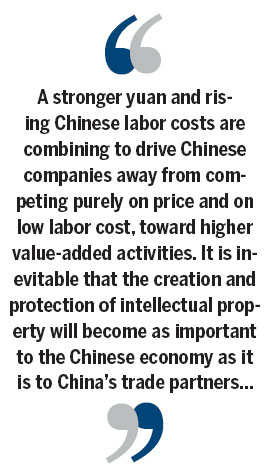Riding the crest of a boom
Updated: 2013-08-23 10:32
By Giles Chance (China Daily)
|
|||||||||||

Chinese legal system and courts are doing a commendable job in protecting intellectual property rights
With the Chinese government starting a nationwide effort to strengthen IPR protection through the legal system and the Chinese courts, it is boom time for intellectual property rights in China.
Last year, the number of civil IPR cases that were received by the courts in China rose by 46 percent year-on-year, to 87,419. The growth has continued at an even faster rate this year. More than 80 percent of the IPR cases heard in 2012 in China were copyright and trademark cases. Disputes over patents, unfair competition and technology agreements made up the rest. More than 2 percent of the cases heard involved non-mainland litigants, a substantial increase from previous years.
There are two main reasons to explain the sudden increase in foreign participation in IPR cases heard by the Chinese courts.
The first and most obvious is the increasing involvement in China of all kinds of manufacturing and service companies from around the world. Many foreign companies, particularly in the United States, have held back from selling or manufacturing in the Chinese market for reasons of cost, as well as for fear that their products will be pirated in China. These companies fear that Chinese competitors will not just take their Chinese market away from them, but eventually their home market as well. They feel that they have no choice but to come and compete in the Chinese market, which is often one of the largest in the world for their products.
Another important reason is that the Chinese legal system and the Chinese courts are doing a much better job than ever before in protecting IPR. By the end of last year, the Supreme People's Court had appointed 83 Intermediate People's Courts to handle patent dispute cases, with 141 grass-root courts given the jurisdiction for general intellectual property cases. Chinese courts stepped up criminal enforcement regarding intellectual property cases, with 13,104 IPR-related criminal cases being heard, and more than 60,000 suspects being detained in the 43,000-plus concluded IPR cases.
Six key IPR laws relating to trademarks, patents, copyrights, civil procedure, patent commissioning and service invention were reviewed and improved in 2012. The Supreme People's Court conducted an important IP Adjudication Conference in collaboration with the US in Beijing, and has also been actively involving itself in other international intellectual property conferences to increase China's awareness of and impact on global IP.
The fundamental driver of China's interest in intellectual property is the number of mainland companies who are creating IP themselves to strengthen and sharpen their competitive edge, both in China and around the world. In 2011, China passed the US and Japan to become the largest filer of patents. With an annual growth rate of 17 percent in patent filing, the World Intellectual Property Organization projects that by 2015 Chinese companies and individuals will be filing 500,000 patents each year, ahead of the US with about 400,000, and Japan with 300,000.
Of course, it's not just volume but quality that counts. The encouragement given by the Chinese government to Chinese companies to file patents is thought by some to undermine the quality of Chinese patent applications. But we can see in ZTE, Lenovo and Huawei's global success, built on innovation, as well as price and efficiency, that Chinese companies are starting to compete very effectively on their own intellectual property.
A stronger yuan and rising Chinese labor costs are combining to drive Chinese companies away from competing purely on price and on low labor costs, toward higher value-added activities.
It's inevitable that the creation and protection of intellectual property will become as important to the Chinese economy as it is to China's trade partners, like Switzerland, with whom China signed its first European free trade agreement in May. China is not just taking intellectual property more seriously than in the past, but equally importantly, is being seen to do so. The consequence of this heightened IP activity is that foreign companies are starting to feel more confident in China's ability to protect IP, and are turning to Chinese courts to maintain their competitive advantage. This is a trend that is bound to continue.
China's economic size, growth and openness to foreign trade will make it a world leader in IP protection by 2020. This will be good news not just for Chinese IP lawyers, but for the millions of foreign companies who will be operating in China by then, as well as for China's consumers.
The author is a visiting professor at the Guanghua School of Management, Peking University.
(China Daily European Weekly 08/23/2013 page9)
Today's Top News
List of approved GM food clarified
ID checks for express deliveries in Guangdong
Govt to expand elderly care
University asks freshmen to sign suicide disclaimer
Tibet gears up for new climbing season
Media asked to promote Sino-Indian ties
Shots fired at Washington Navy Yard
Minimum growth rate set at 7%
Hot Topics
Lunar probe , China growth forecasts, Emission rules get tougher, China seen through 'colored lens', International board,
Editor's Picks

|

|

|

|

|

|





